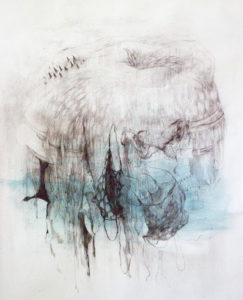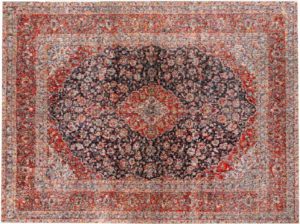
The Asia Society, Talwar Gallery and Aicon Gallery all ended their summers in New York with a show of contemporary art from Pakistan. In different ways, they presented and contested iconic idioms of making art in Pakistan as well as the way in which historical uncertainties are projected into questions for the future. Whether it was a consideration of clothes and the political consequences of how we cover our bodies at theTalwar Gallery, or the renegotiation of traditional miniature painting at the Aicon Gallery, the works were all as deeply entrenched in the language of the past as they are in engaging with present vocabularies.
At the Talwar Gallery, ‘The Emperor’s New Clothes’ curated by Atteqa Ali, focused on clothes as the primary outward sign of culture, class and gender. In the case of this show, clothes are at once a mark of identity, a source of protection, and a harness of control. Naiza Khan created beautiful and intricate armour that mimics the shape of a corset. Both menacing and enticing, these forms could potentially protect and suffocate their wearer, pointing to an area of ambivalence about dress among Pakistani women. AdeelaSuleman took the idea of danger in women’s garments with a touch of humour. By creating hard hats that also can carry water, and helmets that can protect one’s tiffin, Suleman suggested that this danger is ingrained into the motions of women’s everyday life.
Ayesha Jatoi confronted gender-based violence through the story of Chand Bibi, a young girl publicly flogged in the Swat region of Northwestern Pakistan. Using actual footage of the incident, Jatoi highlighted the red of the girl’s shawl, reduced to a helpless heap on the ground. FarheenHaq’s video work unraveled the materiality of the fabrics that cover her, fusinglightness with heaviness and the outside with the inside. RishamSyed’s work stood apart from the others as a suggestion of how clothes can tell the stories of their wearers, and the way in which these items can be passed down as repositories for these memories. Tent of Darius consisted of a line of military coats, each embroidered with the tales of its wearer. The coats were bought from vintage markets, thereby invoking the previous incarnations of their use. They hung quietly, in a way that diminished their martial quality.
The Asia Society selected a group of artists for a glimpse of Pakistani contemporary art, with a line up of artists comparable to Beyond This Page: Contemporary Art from Pakistan from London’sAsia House in 2006. The show, entitled ‘Hanging Fire’ was in some ways also a memorial to ZahoorulAkhlaq, the highly esteemed teacher and pioneering artist who gave discursive shape to Pakistan’s dying tradition of miniature painting. Among his students were the likes of ShaziaSikander and Rashid Rana. Akhlaq was murdered in his home in 1977. Anwar Saeed, a student of Akhlaq’s was present when his teacher was shot by another disciple. He also sustained severe injuries from the incident. Healing in a space of psychological confinement, Saeed drew on the pages of a novel as he grieved. The novel, entitled I Pierre Seel, Deported Homosexual, tells the story of a young Frenchman who is persecuted by Nazis during world War II. A highly layered and complex project dealing with the artist’s own loss and persecution, the interventions in the book were personal and not intended to be shown. Its inclusion in the show was a telling clue as to how curator Salima Hashmi negotiates contemporary art in her country. She constructed the show around the idea of artists working in Pakistan as joined in co-dependent camaraderie, informed by the experience of loss at national and personal levels.

Rashid Rana’sdept to miniature painting is less apparent, although the minute details of his work are really what propel the narrative aspects of his compositions forward. In Red Carpet I, Rana creates an image of a woven carpet, the quintessential symbol of Islamic culture and trade. However, in his signature style, a closeup view of the pixelations of the overall image can be broken down into photographs of a bloodbath. The image shifts from a micro to a macro level, never reaching a totality and constantly subverting its own meaning. MahreenZuberi paints banal objects, strangely drawn out of their daily context and given a meaning that can be allegorical or specific. As she engages with miniature painting, the unfinished quality of her images focuson the violence implicit in everyday activities. HumaMuji’sHighRise: Lake City Drive places a buffalo on a Corinthian column, imagining the plight of keeping up with the ever-increasing pace of urban development and globalization. BaniAbidi’sfilm, Shan Pipe Band Learns The Star Spangled Banner from 2004, records the attempts of a local band in Lahore learning to play the American national anthem. The attempts were earnest as well as clumsy, reflective of the strange and opaque relationship between the two countries.
HasnatMehmood’s solo exhibition, entitled ‘I Love Miniature’,at the Aicon Gallery presented interesting examples of the artist’s work. Borrowing the title of Rashid Rana’sphotomontage that created a Mughal Miniature painting, Mehmood’s fourteen pieces were little jewels of details which combine and layer multiple images and references. In a kind of schizophrenic back and forth, the pictures were divided up into a grid-like formation but went beyond the lines and bounds of these markings. The images drew attention to the methods of traditional miniature painting which depends on precision and copying. Mehmood reinterpreted and critiqued these tropes by breaking up the spatial and pictorial cohesion of the works and by adding in deviant references.
All of these shows tried to push aside monolithic ways of seeing Pakistani art by managing the viewer’s expectations. Amidst the normal criticism that contemporary art in Pakistan is derivative, the works on show this summer adamantly insisted that Pakistani artists are dealing with a wide array of issues while asking interconnected questions on a global scale.
Image Courtesy: Avni Doshi.













